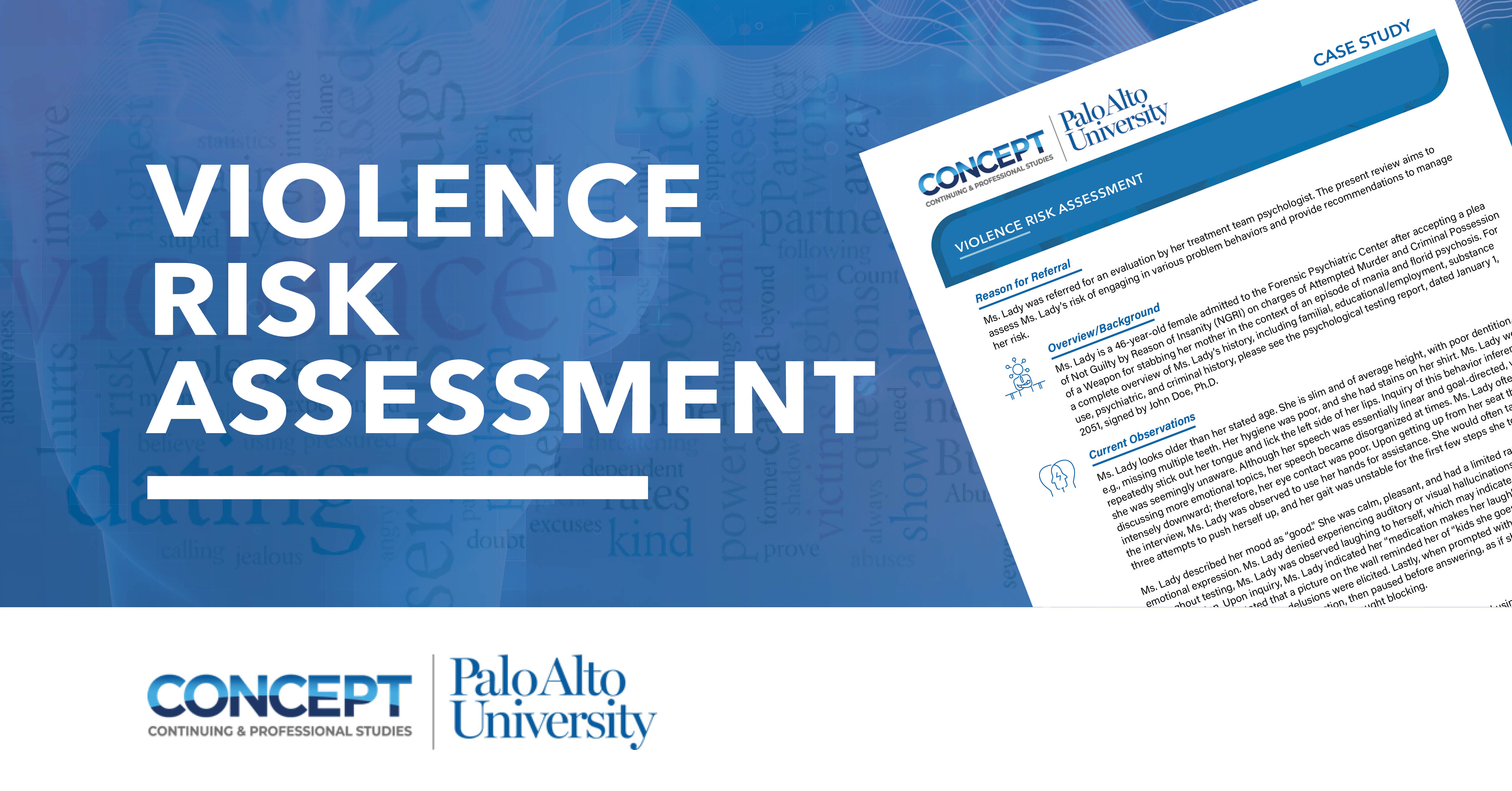- Reason for Referral
- Overview/Background
- Current Observations
- Risk Assessment Formulation
- Risk of Violence
- Risk of Being Victimized
- Risk of Self-Harm and Risk of Suicide
- Risk of Unauthorized Leave
- Risk of Substance Abuse
- Risk of Self-Neglect
- START-Strengths
- Summary and Recommendations:
- Violence Risk Assessment Certificate
Reason for Referral
Ms. Lady was referred for an evaluation by her treatment team psychologist. The present review aims to assess Ms. Lady’s risk of engaging in various problem behaviors and provide recommendations to manage her risk.
Overview/Background
Ms. Lady is a 46-year-old female admitted to the Forensic Psychiatric Center after accepting a plea of Not Guilty by Reason of Insanity (NGRI) on charges of Attempted Murder and Criminal Possession of a Weapon for stabbing her mother in the context of an episode of mania and florid psychosis. For a complete overview of Ms. Lady’s history, including familial, educational/employment, substance use, psychiatric, and criminal history, please see the psychological testing report, dated January 1, 2051, signed by John Doe, Ph.D.
Current Observations
Ms. Lady looks older than her stated age. She is slim and of average height, with poor dentition, e.g., missing multiple teeth. Her hygiene was poor, and she had stains on her shirt. Ms. Lady would repeatedly stick out her tongue and lick the left side of her lips. Inquiry into this behavior confirmed that she was unaware she was doing it. Although her speech was essentially linear and goal-directed, when discussing more emotional topics, her speech became disorganized at times. Ms. Lady often stared intensely downward, making poor eye contact. Upon getting up from her seat throughout the interview, Ms. Lady was observed to use her hands for assistance. It would often take her two or three attempts to push herself up, and her gait was unstable for the first few steps she took.
Ms. Lady described her mood as “good.” She was calm, pleasant, and had a limited range of emotional expression. Ms. Lady denied experiencing auditory or visual hallucinations. However, throughout testing, Ms. Lady was observed laughing to herself, which may indicate internal preoccupation. Upon inquiry, Ms. Lady said her “medication makes her laugh” and, on another occasion, stated that a picture on the wall reminded her of “kids she goes to school with.” No paranoid or persecutory delusions were elicited. Lastly, when prompted with a question, Ms. Lady repeated one word of the question, then paused before answering as if she was searching for the words or experiencing thought blocking (when an individual is suddenly unable to think, speak, or respond to events happening around them).
Risk Assessment Formulation
To assess Ms. Lady’s risk in several domains, Ms. Lady was evaluated using the Short Term Assessment of Risk and Treatability (START). The START is a 20-item instrument inclusive of dynamic (i.e., those that can be modified with interventions and monitoring) risk and protective factors. The START is used to evaluate violence and other problem behaviors and was coded focusing on information, behaviors, and symptoms within the preceding three months since her admission. An assessment of risk was based on her projected functioning for the next three months, focusing on risk while at the Forensic Hospital.
Risk of Violence
According to her records, Ms. Lady stabbed her mother, Mrs. Lady, several times in the face, neck, and upper torso, actions that resulted in her death. In the hours before the offense, Ms. Lady had a “vision” of a child warning her to protect her mother.
Since then, Ms. Lady has engaged in various acts of violence. She reported one prior physical altercation while in jail, which resulted from another inmate threatening her. She also said she had verbally argued with other inmates while in jail but reported that she did not receive any incident reports or sanctions. Despite having a history of physical aggression, Ms. Lady has not had any violent incidents or arguments with staff or patients.
Currently, Ms. Lady poses a Moderate risk of violence in the hospital. While she has not been violent since she was admitted to the hospital and progress notes document, she keeps to herself and complies with ward policies and procedures. She presents a history of poor impulse control that has led to her violent behavior. Further, although limited, she could name some coping strategies for when she experiences symptoms or is triggered, including drinking water and coloring, which help her calm down. Ms. Lady reported being triggered by things in her environment, such as loud noises, but thus far has been able to cope with these situational factors adequately. Further, she appears to benefit from having social support as she reported speaking to her friend and sister on the phone throughout the week. Social support and coping skills likely protect Ms. Lady from acting aggressively in the hospital.
Risk of Being Victimized
Ms. Lady reported experiencing harmful and traumatic events during her childhood and adulthood. She described being sexually assaulted by her cousin when she was 13 years old and by a roommate for two years as an adult. Additionally, she reported a history of perpetrating and experiencing emotional abuse from her mother and aunt throughout her life. These experiences likely disrupted her normative development and learning of problem-solving skills. Additionally, Ms. Lady experienced her brother’s death while being institutionalized. Treatment team members have opined that she may harbor potential “unprocessed grief and has not fully processed the loss of her mother and brother. Lastly, Ms. Lady presents as frail. She struggled to get up from her seat and was uneasy on her feet upon standing. This may suggest to others that she is an easy target, as she cannot physically defend herself or easily remove herself from the situation.
Ms. Lady presents a High risk of being victimized. Although the secure nature of the Forensic Hospital will ideally protect against occurrences of victimization, Ms. Lady is isolated on the ward and reports not having trust in her treatment team. Therefore, she is unlikely to report times when she may feel unsafe to staff or trusted peers. For instance, Ms. Lady detailed an event where a male patient approached her in the recreation yard and sat next to her while staring at her; she did not discuss these instances with her treatment team. Further, Ms. Lady’s history includes situations where she has exercised poor judgment. For example, she reported being raped by a roommate over two years. Although she did not provide extensive details about these circumstances, her report of the occurrence does not reflect an attempt to leave this situation, which may have resulted from limited housing options, as she also reported a history of homelessness. Finally, Ms. Lady demonstrated low self-worth and appeared desensitized by trauma as she described past trauma in a monotone voice with no fluctuation in affect. These factors contribute to her risk of victimization while in the hospital.
Risk of Self-Harm and Risk of Suicide
Ms. Lady has engaged in self-injurious behavior when acutely psychotic and depressed. Ms. Lady reported numerous prior suicide attempts beginning when she was 12. During her first suicide attempt, she planned to overdose on unspecified pills but threw up in the process; she said she did not tell anyone about her attempt. During her current hospitalization, she attempted suicide by swallowing her commissary key twice. She has also refused food to the point where she has become medically unstable, requiring hospitalization. She has a long history of thoughts of suicide and self-harm, particularly in the face of stressors, for example, during periods of adjustment to incarceration and institutionalization. An extended period of stability on her medication regimen may confer some protection; however, Ms. Lady remains at risk for future suicidal thoughts or self-injurious behavior. During the evaluation, Ms. Lady denied current suicidal ideation or plans to engage in self-injurious behaviors.
Currently, Ms. Lady presents a High risk of self-harm and suicide. While the secure nature of the hospital will likely serve as a protective factor against her risk in these domains, Ms. Lady presents with poor impulse control and a lack of adequate coping skills. In addition, she engaged in a previous suicide attempt while hospitalized and under observation, increasing her risk of suicide in an institutional setting. She reported that she often decides to attempt suicide impulsively. Thus far, she has not demonstrated adequate coping skills to protect against such impulsivity in the hospital.
Risk of Unauthorized Leave
There is no evidence that Ms. Lady has attempted to elope from a hospital. Additionally, she reported at least a superficial understanding that she needs to adhere to the rules while in the hospital. Although she is unhappy about currently being hospitalized, she stated she usually follows the rules and plans to continue to do. Additionally, Ms. Lady has a history of homelessness, and the two individuals that provide her social support are either out of state or incarcerated at this time and thus inaccessible to her. Therefore, Ms. Lady’s risk of unauthorized leave is Low.
Risk of Substance Abuse
Ms. Lady has a history significant of using multiple substances, including alcohol, marijuana, cocaine, ecstasy, and others. Her substance use has aggravated her psychotic and mood symptoms and violence in the past. She reported a history of engaging in physical aggression in the context of consuming alcohol; however, she indicated that none of the physical fights she has engaged in have resulted in severe injuries to anyone involved. Ms. Lady’s treatment should support her in making considerable strides in understanding the link between her substance use, psychiatric decompensation, and violence. At present, she does not demonstrate a solid commitment to continuing sobriety. For Ms. Lady, substance use exacerbates her psychiatric symptoms and, subsequently, her risk for violence. While in the hospital, Ms. Lady’s risk of substance use is Low. She is unlikely to be exposed to drugs or alcohol; however, if substances become available in contraband, she may try to obtain them.
Risk of Self-Neglect
Ms. Lady’s risk of self-neglect is Moderate. During the current evaluation, Ms. Lady appeared not to have showered recently and had stains on her clothing. Nursing notes document encouragement to attend self-care practices such as showering and changing her clothes. Ms. Lady reported that she has been sleeping less recently and requires sleeping medication. Ms. Lady could not identify a reason for the recent change in her sleep hygiene. Ms. Lady has demonstrated medication compliance (supported by hospital records). Her self-care practices, medication compliance, sleep, and overall health should be monitored.
START-Strengths
Although Ms. Lady presents several risk factors for victimization, self-harm, suicide, substance abuse, and self-neglect, she presents strengths that may lessen the likelihood of these behaviors. Specifically, Ms. Lady has complied with her psychotropic medications while at the hospital. Although she is still experiencing psychiatric symptoms, her compliance with these medications has likely helped stabilize some of her symptoms and brighten her emotional expression. Further, Ms. Lady perceives herself as having social support. She reportedly speaks to her sister daily and her friend at least once weekly over the phone. She also reported that she is looking forward to events in the future, such as the hospital BBQ.
Summary and Recommendations:
In summary, Ms. Lady presents a High risk of victimization and self-harm, suicide, and a Moderate risk of violence and self-neglect. Her risk is the presence of ongoing mood and psychotic psychiatric symptoms, impulsivity, trauma history, and lack of coping skills. She demonstrates Low risk in the START domains of substance use and unauthorized leave. Given Ms. Lady’s ongoing psychiatric symptoms, it is recommended that she continue to meet with her psychiatrist to reassess her treatment needs/medications.
Ms. Lady will likely benefit from interventions that will enable her to cope more effectively with her low mood, irritability, and distress without self-harm. Additionally, Ms. Lady would benefit from groups that will help her to utilize current coping skills (e.g., drawing, reading) and develop new skills, regulate her emotions, tolerate frustrations, and effectively communicate her needs. She may also benefit from individual therapy that focuses on helping her to process her history of interpersonal trauma and develop trust with her treatment team to help her alleviate some of her negative emotions when she is in distress. Moreover, Ms. Lady should have the opportunity to process the losses of her brother and mother, as the lingering grief may be a destabilizing factor and increase her violence.






















